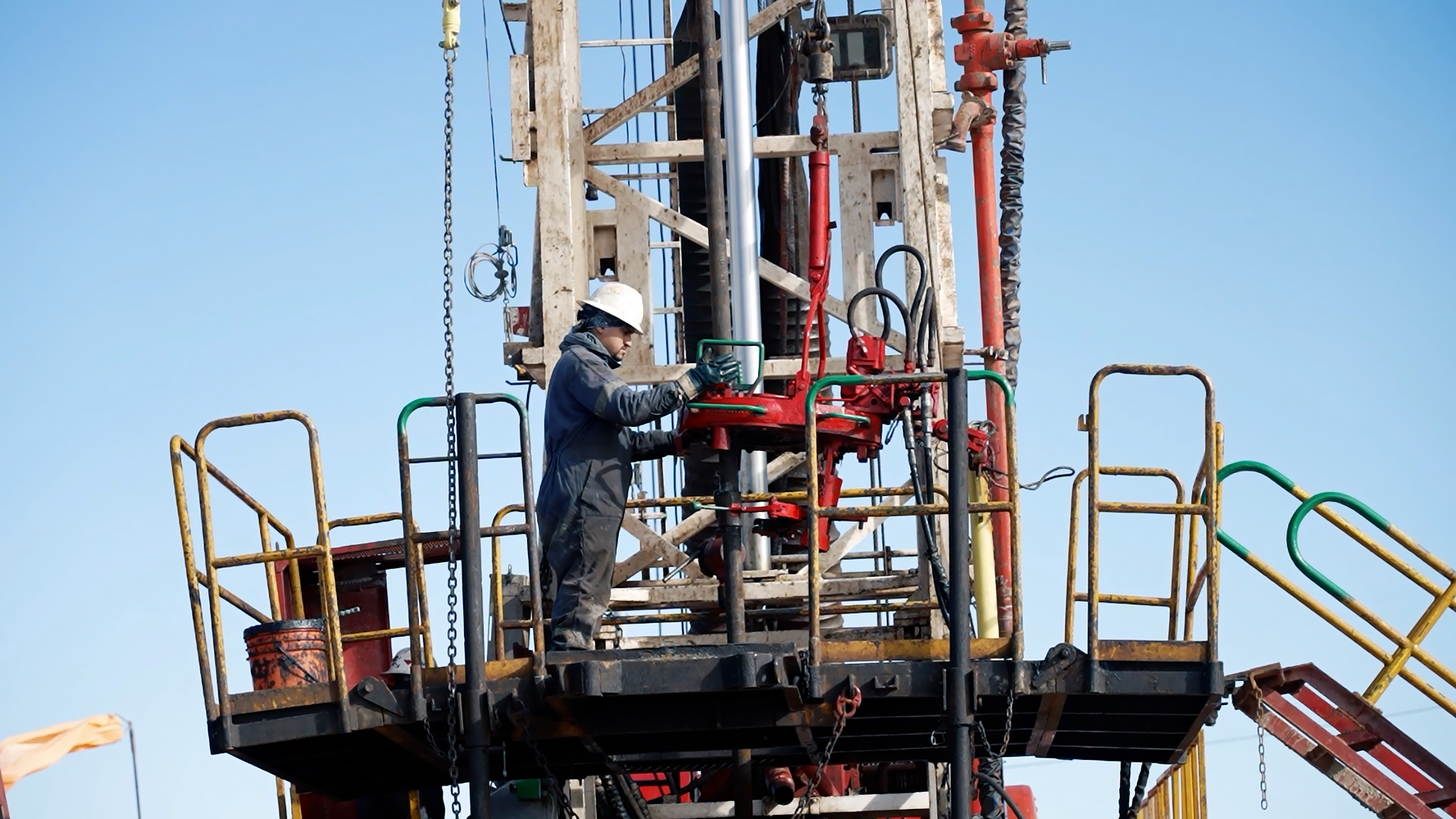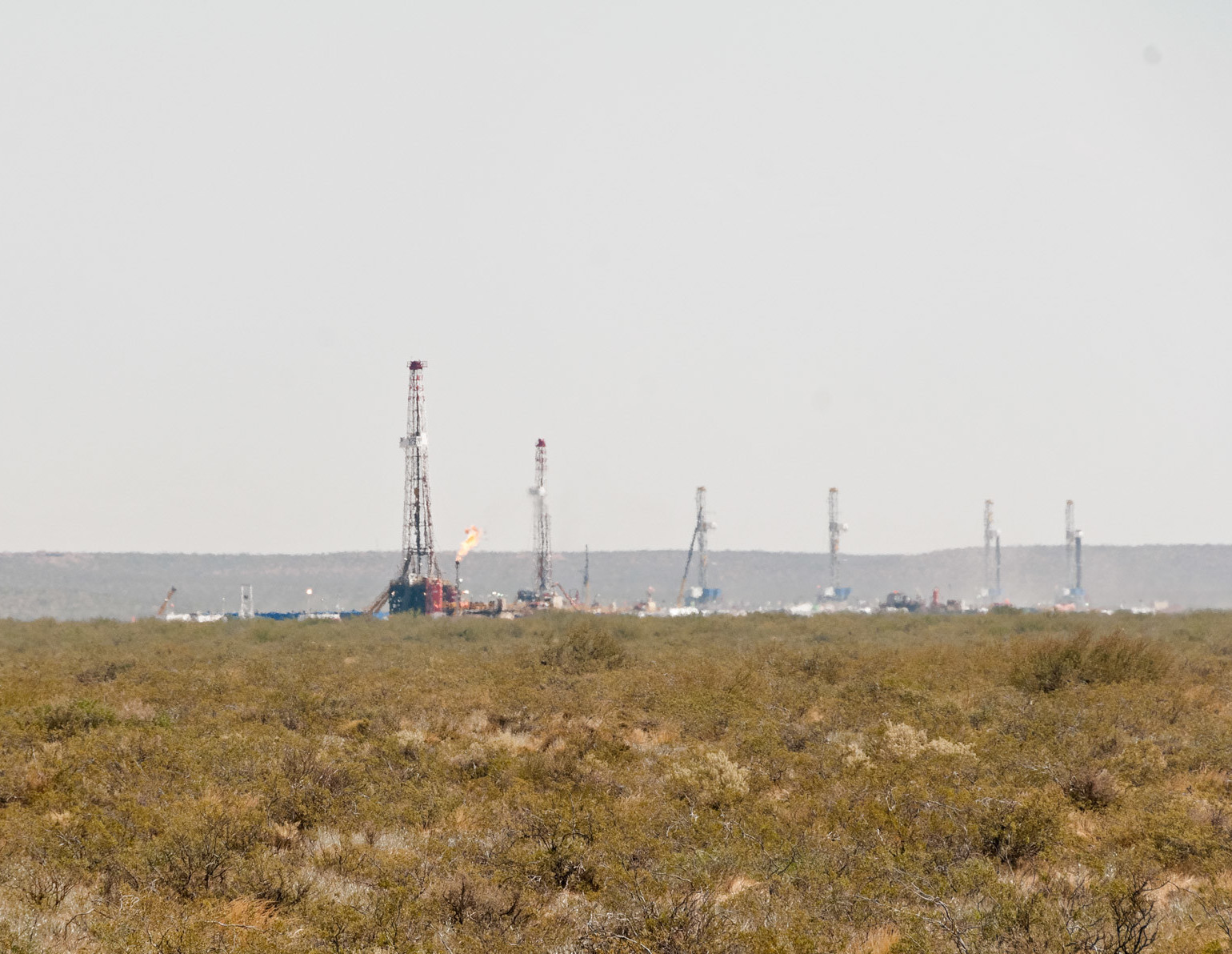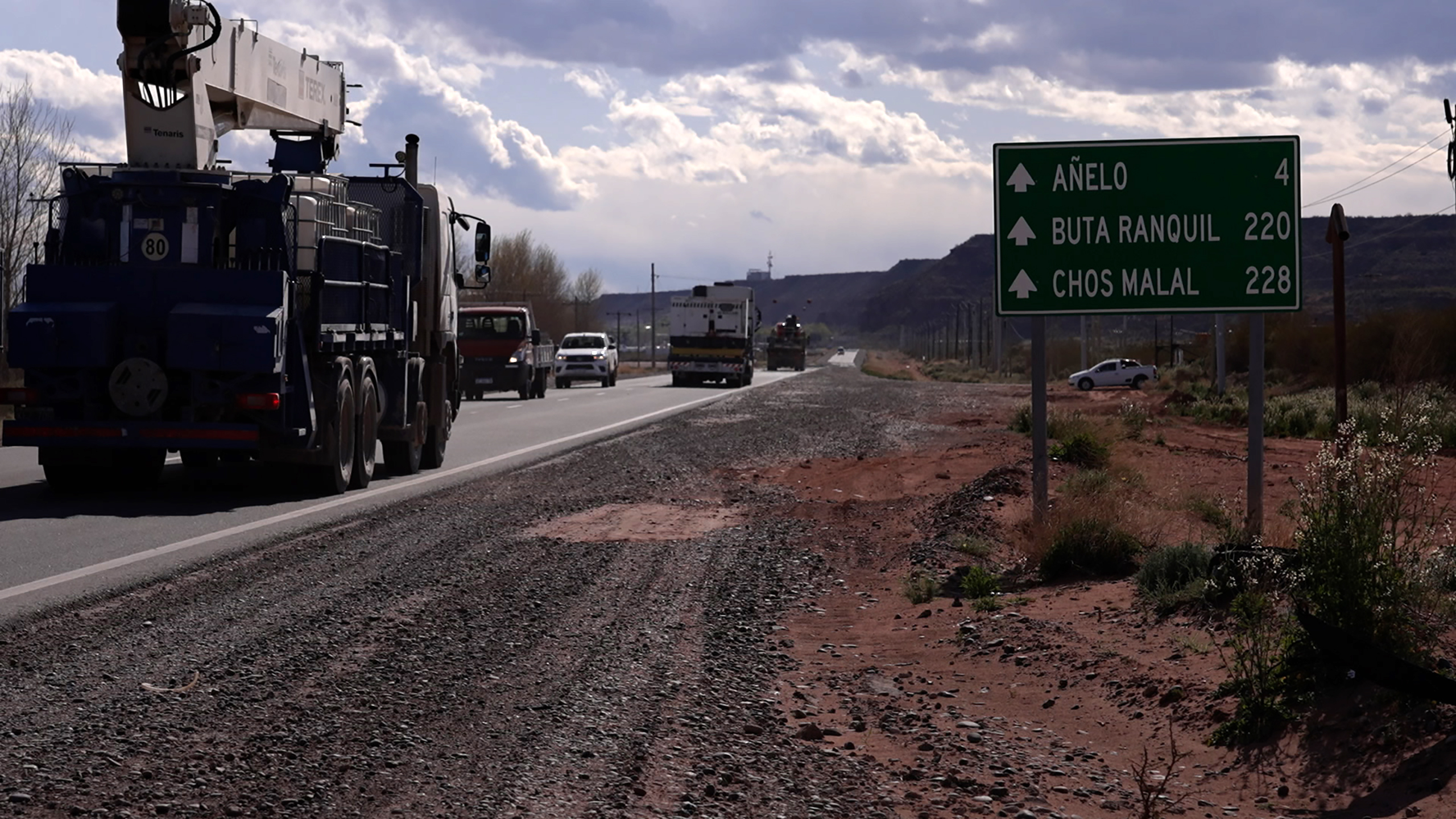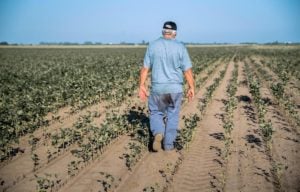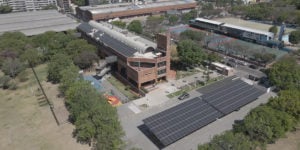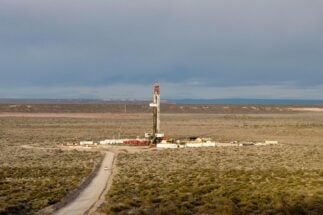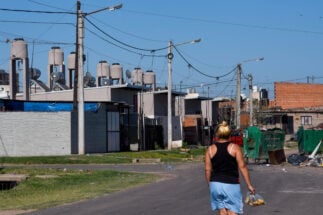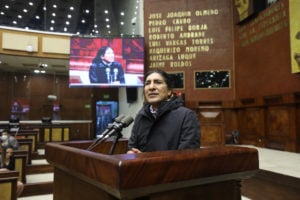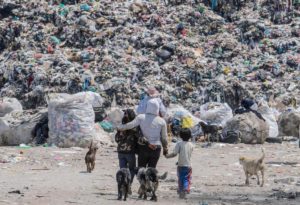Añelo is a town marked by contrast. In the lowlands of its valley, fertile soils spread from the banks of the Neuquén River, while up on the nearby plateau, the ground turns to a clayey desert. The former represents the rural Añelo of yesteryear; the latter, the oil-producing Añelo, where the vast reserves of the Vaca Muerta basin are located.
Located in the western province of Neuquén, the gateway to Argentine Patagonia, Añelo used to be a quiet town of some 1,500 inhabitants, mostly farmers and ranchers. But since 2011, when extraction began at Vaca Muerta, there has been a stir in the town.
Stretching across Neuquén and into the provinces of Mendoza, Río Negro and La Pampa, the Vaca Muerta formation contains the second-largest shale gas reserves in the world and the fourth-largest unconventional oil reserves.
Next door to these vast resources, however, many of the local population still heat their homes and cook with firewood or bottled gas. The scarcity of services in a town rich in hydrocarbons is a daily reality for its now 7,500 inhabitants.
On a dirt road that crosses the plateau, there is a constant passage of trucks loaded with oil, sand for fracking, and pipes and products for all this industry. To the sides of the track sits the “new city of Añelo”, an area that began to be built as part of a plan that envisaged some 30,000 people settling here as a result of the great growth that would be seen following the discovery of shale gas and oil.
Today, there are more than 700 families living there who have no gas or sewage connection and, in some cases, no electricity. The water network is supplied by the same aqueduct that YPF, the majority state-owned oil company, built to capture liquid from the Neuquén River and use it for fracking, the extraction process used at Vaca Muerta. But the network does not reach all homes.
In the local dialect, those who live here call it living “above”, differentiating themselves from those who live “below”, in the older part of town.
A forgotten place
Before the Conquest of the Desert, a military campaign conducted by the Argentine government between 1879 and 1885, in which it seized large tracts of territory in Patagonia, Añelo was home to Indigenous Pehuenche and Ranquel peoples. In their language the name means a “forgotten place” or “swamp of death”.
“One of the major issues for Añelo is the lack of infrastructure,” acknowledges Milton Morales, the town’s mayor. “Our town was very incipient in 2011. We had just 1,500 inhabitants and it was not designed to grow as it did.”
According to Morales, after the discoveries at Vaca Muerta, the municipal government started working on a growth plan for 2030. However, the funds promised to accompany the arrival of new inhabitants did not materialise as expected.
“We have serious shortcomings, especially with gas provision, which is so contradictory in a place where the largest oil and gas extraction in the country takes place today, and which is regarded as one of the best places in the world,” he says.
The shale boom
In 2013, after the discovery of Vaca Muerta’s reserves, Miguel Galuccio, then president of YPF, boldly announced: “The shale boom has begun.” Three months later, on 28 August, the Neuquén legislature approved an agreement between YPF and US oil and gas giant Chevron.
Following this agreement, the Loma Campana block, here in Añelo, became the second most important oil and gas field in the country and the first large-scale unconventional development outside the US and Canada. Vaca Muerta is estimated to have recoverable resources of 308 trillion cubic feet of gas and 16.2 billion barrels of oil.
The Neuquén governor at the time, Jorge Sapag, struck an agreement with the national government for compensation of 1 billion pesos (then equivalent to US$180 million) to account for the impacts of the arrival of the hydrocarbon industry. This included 64 public works, mostly for the town of Añelo, including schools, hospitals, infrastructure and housing. The funds were slow to arrive.
“The only thing we have from the YPF-Chevron agreement is the hospital,” says Morales. “It is the only thing that has been completed and put into operation. The rest of the projects that were part of the agreement and that were intended to support Añelo were never implemented.”
It is estimated that three or four new families arrive every week, lured by the prospect of attractive oil salaries and a job in the hydrocarbon industry. “People overestimate Vaca Muerta,” says Morales, questioning the number of people who arrive hoping to find new opportunities.
At the same time, the real estate sector saw fertile ground in Añelo. Today, the main investments in flats, family homes and hotels come from private investors. Though there is demand for housing, it is often at prices inaccessible to most newcomers.
‘This is Vaca Muerta’
In 2014, the authorities of Añelo and Neuquén unveiled a development masterplan to 2030, a project financed by the Inter-American Development Bank (IDB), and created jointly by YPF and the provincial and national governments. It foresaw a new city in Añelo: 30,000 people would live there, and cinemas, supermarkets, sports centres, planned neighbourhoods, schools, hotels, banks, two health centres and a fire station would be built.
With seven years to go until the plan’s target date, little progress has been made.
Adela López lives there, in one of the 100 houses built by the national and provincial governments to respond to the abrupt population growth. In her newly constructed home, there is a space heater that runs on firewood, while the cooker uses gas from a cylinder.
“We get too cold here,” says Adela. “The houses get rained on during storms and water runs down the walls. This winter was harsh: it rained, snowed and got very cold.”
Something is not right… A gas cylinder in Vaca Muerta is more expensive than in Buenos AiresAndrés Mena, a shopkeeper in Añelo
In 2022, extremely low winter temperatures were recorded in Neuquén, with snowfall extending from April to November in the province’s mountainous areas. In Añelo, snow came in July and August, and low temperatures remained until October.
For those who live there, the only way to cope with cold weather is to buy firewood and gas cylinders. A typical bundle of firewood lasts about 15 days, and a cylinder up to a week. Adela says that, in 2022, demand exceeded the amount of firewood available: “We all suffered, including the neighbours with children, because there was no firewood. Whatever the municipality had, it was not enough.”
“This is Vaca Muerta,” Adela says, with a gesture of resignation.
“We are standing on the most important gas field and, on the plateau, 70% of the houses have wood-burning cookers and smoky walls,” says Andrés Mena, a local shopkeeper. “Something is not right… A gas cylinder in Vaca Muerta is more expensive than in Buenos Aires.”
In search of the ‘Argentine Dubai’
In the same housing complex where Adela lives, there are another 60 families. On 1 August last year they moved to illegally occupy a group of houses that remained abandoned and unfinished, after the company in charge withdrew without finishing the works. They have no gas, electricity, water or sewage. Some houses also have no windows or toilets.
“We are not going to leave, because we have nowhere to go,” says Jimena, who paid as much as US$780 a month in rent before living in this informal neighbourhood. “The demands of rent are very high, and you have to work to pay the rent and eat.”
Most of the occupants here are young families with small children who came to Añelo in search of work and a new life. On a daily basis, they are joined by others from other provinces – Santa Cruz, Mendoza, San Juan, northern Argentina. Others come from Chile, and even Colombia. Such is the case of Jimena, who travelled from the northern province of Salta six years ago: “We heard that there is work in Vaca Muerta, that it is ‘the new Dubai’, and we came to try it out.”
According to Jimena, the jobs are there, but there is no formal place to live.
“These houses [that the families occupied] have been vacant for three years,” says Karen, 26. She arrived from Mendoza looking for a new life, and her partner got a job as a waiter in a restaurant. Difficulty in paying the rent was what led them to occupy one of the abandoned buildings.
We don’t have anything. Not even a hospital. And the roads are a disasterMariela, Añelo resident
Karen says companies and agents “abuse those of us who come to work: they charge up to 100,000 pesos [US$410] for a room and a bathroom.” The high cost, she points out, is also reflected in the prices of foods, and other basic commodities such as drinking water.
Added to this situation is a list of shortages throughout the city, says Mariela, a native of the area. “We don’t have anything. Not even a hospital. And the roads are a disaster,” she complains. “Being Vaca Muerta, where the gas and oil comes from, we should be at a better level.”
No man’s land
About 30 kilometres before reaching Añelo lies Punta de Sierra, a settlement where some 45 families live. It is also where the entrance road to the Sierras Blancas gas and crude oil processing plant begins. The facility belongs to British multinational Shell, which operates more than 100 wells at Vaca Muerta.
Locals in this area describe it as a “grey zone”, as it has not historically been considered part of the municipalities of Añelo or San Patricio del Chañar, another town 21 kilometres away. With no taxes coming in, it also has no services – no gas, electricity, drinking water or waste collection. Despite this, some families have lived there for 40 years.
“I’ve been living here for 13 years,” says Marta Torres, one of the oldest residents, who bought her land several years ago. “I have my house, but I don’t have any basic services, only a doctor in a nearby clinic.”
According to her, the land belonged to a private owner who later abandoned it. The provincial government decided to take over the land in 2021 in order to begin to formalise the situation of those who live there, but also asked them to pay a tax debt.
Among the demands residents have made to the provincial government is a request for access to drinking water – they only have use of a well, bringing water with a high degree of salinity – as well as electricity and gas.
The lack of gas affects their daily lives: bathing or having hot water for other tasks requires heating it in the kitchen with expensive bottled gas, and sourcing cylinders from several kilometres away.
“It is unpleasant to live without gas,” says Marta. “Besides, I can’t use the water heater because the well water is full of scale and breaks our pipes. We heat water to bathe, wash, clean the house, and we buy water bottles that are very expensive.”
Marta expresses the same anguish as many other residents living in this apparent contradiction: “We are people who live on top of Vaca Muerta and lack everything.” Much like other neighbours, she wonders what action they must take to see their demands realised, and to live as she hopes to: “We feel very helpless. We see how the millions go by, and nobody is able to provide us with anything, neither the government nor the companies.”
It is six o’clock in the evening, and the passing of trucks and minibuses is incessant on the side of the road. It is a long line of vehicles returning to the capital of Neuquén, taking the workers of the oil and service companies to their homes.
The sun sets in the west, over the plateau, and the gas lighters from the flaring of the wells light up the sky. In August 2022, Vaca Muerta reached an all-time production record of 91 million cubic metres of gas per day, and the field is close to becoming one of the world’s largest producers.
In the meantime, on this rich soil, some of its inhabitants are waiting for promises to be fulfilled. They no longer care to see the birth of a new Dubai, only to bathe in hot water or to be able to live at ease, beside the warmth of an oven.
This article was produced by Periodistas por el Planeta (PxP), a climate journalism network, and is republished here under a Creative Commons License.
